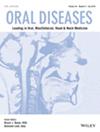Emerging roles of the renin‐angiotensin system in select oral diseases
IF 2.9
3区 医学
Q1 DENTISTRY, ORAL SURGERY & MEDICINE
引用次数: 0
Abstract
ObjectivesThe renin‐angiotensin system (RAS) plays essential roles in cardiovascular and renal function regulation. Recent studies have shown that the RAS components are widely expressed in oral tissues, but their roles in oral diseases remain underexplored. This review aims to summarize the effects of the RAS in select oral diseases including oral squamous cells carcinoma (OSCC), periodontitis, oral submucous fibrosis (OSF), and ageusia/dysgeusia.Subjects and MethodsData searches were performed using PubMed, Web of Science and Scopus through July 2024. A narrative overview of current literature was undertaken to synthesize the contexts with elaboration and summary.ResultsIn OSCC, ACE/Ang II/AT1R promotes OSCC by inducing angiogenesis, cell proliferation and invasiveness. Conversely, ACE/Ang II/AT2R and ACE2/Ang (1–7)/MasR inhibit OSCC progressions. In periodontitis, ACE/Ang II/AT1R upregulates inflammatory cytokines and promotes osteoclast differentiation factor RANKL, whereas ACE2/Ang (1–7)/MasR exerts opposite effects by preventing inflammation and alveolar bone loss. In OSF, Ang (1–7) counters the profibrotic and proinflammatory action of Ang II. In dysgeusia, Ang II suppresses salt taste responses and enhances sweet taste sensitivities, while Ang (1–7) exhibits opposite effects.ConclusionsThe RAS cascade plays crucial roles in OSCC, periodontitis, OSF and ageusia/dysgeusia. The imbalanced RAS may aggravate the progression of these diseases.肾素-血管紧张素系统在某些口腔疾病中的新作用
目的肾素-血管紧张素系统(RAS)在心血管和肾功能调节中发挥着重要作用。最近的研究表明,RAS 成分在口腔组织中广泛表达,但它们在口腔疾病中的作用仍未得到充分探索。本综述旨在总结 RAS 在特定口腔疾病中的作用,包括口腔鳞状细胞癌(OSCC)、牙周炎、口腔黏膜下纤维化(OSF)和老年性口腔溃疡/牙龈萎缩。结果在 OSCC 中,ACE/Ang II/AT1R 通过诱导血管生成、细胞增殖和侵袭性促进 OSCC。相反,ACE/Ang II/AT2R 和 ACE2/Ang (1-7)/MasR 可抑制 OSCC 的发展。在牙周炎中,ACE/Ang II/AT1R 上调炎症细胞因子并促进破骨细胞分化因子 RANKL,而 ACE2/Ang (1-7)/MasR 则发挥相反的作用,防止炎症和牙槽骨流失。在 OSF 中,Ang (1-7) 可对抗 Ang II 的促破坏和促炎症作用。结论:RAS 级联在 OSCC、牙周炎、OSF 和老年性口腔炎/口腔溃疡中起着至关重要的作用。失衡的 RAS 可能会加剧这些疾病的发展。
本文章由计算机程序翻译,如有差异,请以英文原文为准。
求助全文
约1分钟内获得全文
求助全文
来源期刊

Oral diseases
医学-牙科与口腔外科
CiteScore
7.60
自引率
5.30%
发文量
325
审稿时长
4-8 weeks
期刊介绍:
Oral Diseases is a multidisciplinary and international journal with a focus on head and neck disorders, edited by leaders in the field, Professor Giovanni Lodi (Editor-in-Chief, Milan, Italy), Professor Stefano Petti (Deputy Editor, Rome, Italy) and Associate Professor Gulshan Sunavala-Dossabhoy (Deputy Editor, Shreveport, LA, USA). The journal is pre-eminent in oral medicine. Oral Diseases specifically strives to link often-isolated areas of dentistry and medicine through broad-based scholarship that includes well-designed and controlled clinical research, analytical epidemiology, and the translation of basic science in pre-clinical studies. The journal typically publishes articles relevant to many related medical specialties including especially dermatology, gastroenterology, hematology, immunology, infectious diseases, neuropsychiatry, oncology and otolaryngology. The essential requirement is that all submitted research is hypothesis-driven, with significant positive and negative results both welcomed. Equal publication emphasis is placed on etiology, pathogenesis, diagnosis, prevention and treatment.
 求助内容:
求助内容: 应助结果提醒方式:
应助结果提醒方式:


